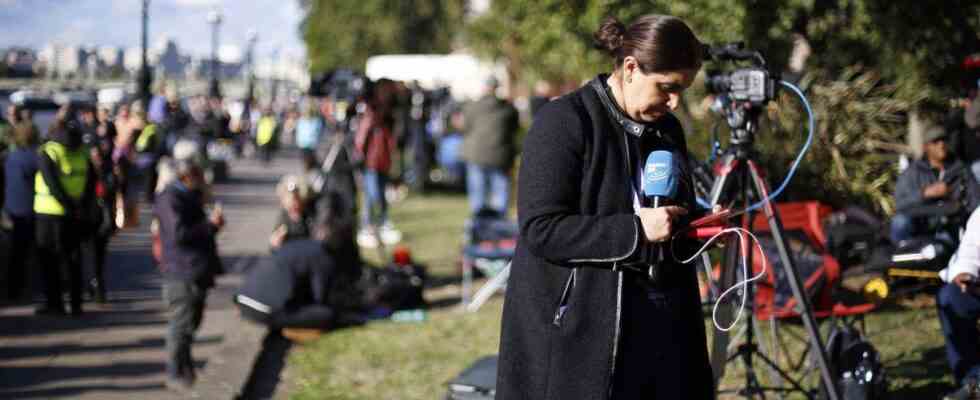It is an event that is meant to be historic. More than 2,000 dignitaries and guests, including 500 heads of state, hundreds of thousands of people who attended the broadcast of the ceremony across London, and hundreds of television channels who never missed a beat. Elizabeth II’s funeral is expected to draw crowds and break all audience records: it is estimated that more than 4 billion viewers will have followed the funeral live.
Dizzying figures, for the one whose coronation had been followed by 277 million viewers in the world in 1953. Since Thursday September 8, almost all the newsrooms in the world, and particularly the television channels, have sent to London and other other cities in the United Kingdom an army of journalists and reporters, to cover this historic event. Audiences for the main non-stop television channels, from BFMTV to France Info, increased by almost 1 point compared to their usual average. Across the Channel, more than 33 million viewers watched the Queen’s final hours live.
A globalized, precise and widely commented event
For many media, particularly British, coverage of the event has been considered for years, as it was expected. For Virginie Spies, lecturer at the University of Avignon, semiologist and media analyst, “it’s a huge media and historical moment”. “From Bangladesh to the Ardèche, we are in an event shared by all, in a communion that is part of mainstream culture,” she explains. It is therefore not surprising that the event fascinates. “The media are fond of that. It’s a godsend for television to play its primary role: to show something live and that it touches people,” she adds.
On Monday morning, as the funeral unfolded, televisions around the world showed the same footage, produced by the BBC in conjunction with Buckingham Palace. The continuous news channels, like BFMTV, then keep the antenna for days, pass the microphone to the witnesses, to the experts on set, fill the silences. “The idea is to keep people around because something can always happen! Except that in a ceremony like this, everything is to the millimeter, so nothing unexpected should happen” analyzes Virginie Spies. Hence the importance of having good chroniclers and renewing knowledge, analyses, sound bites.
The royal funeral, more important than the climatic disaster?
But the media omnipresence of the royal funeral looks like a broken record, which would play the same information, the same images, the same names over and over again. “The media look at each other, it’s as if the media space was saturated” notes Virginie Spies. For the past week, the whole world has seemed to revolve around Buckingham Palace and its crowned heads. A media system that sometimes has its limits, such as the omnipresence of farewells to the queen in the United States, a country very far from the monarchy in many respects. In the Philadelphia Inquirermany American citizens admit that they do not fully understand the importance given to this event in their country.
In the Guardian, environmental researcher Euan Ritchie let out a heartfelt cry: “Why is the death of the queen receiving such media coverage while the future of the Earth is ignored? “. He is not the only one to denounce the central place of the death of the queen in the pages of the newspapers, while elsewhere in the world, the climate crisis or the war in Ukraine continue to rage. While the queen makes the full pages, many other events are ignored, or do not have the same resonance. But that’s not counting social networks.
Between dissenting voices and focus point
If the death of Elizabeth II is a global event, it is now inseparable from the means of communication that accompany it: television or radio are no longer the only media used, we must also rely on social networks. Between Instagram stories populated with images of the queen in black and white and Tik Tok videos recalling the colonialist heritage of Great Britain, social networks are also making dissident voices heard. “We must not forget that it is a screaming minority, especially for Twitter. And the media use Twitter a lot, so these two media feed off each other,” recalls Virginie Spies. The Queen’s funeral is also the end of more than ten days of intense, sometimes nonsensical media coverage. “After 12 days, all the media no longer know how to illustrate this subject, all facets have been explored” adds the media analyst.
In an article from The Conversation, the Australian researcher Denis Muller wrote that by being part of the system, the mass media were obliged to conform to very strong political and social expectations. Among which, to give importance to this type of event, to promote unity rather than division, respect rather than criticism, and the status quo rather than radical change. With a battery of very precise rules, Buckingham Palace did not give the media covering the event too much leeway: which led to media coverage that followed and resembled each other, from the fate of the Queen’s Corgis to its legacy. If in a few hours, the United Kingdom will have to turn the page of a reign, the media will also have to find a new topical point.

